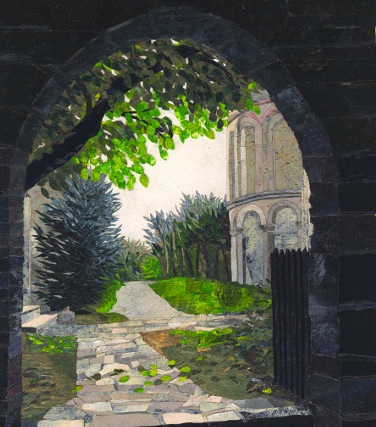Mosaico minuto, American-style
If you want to see yet another way obsession gives birth to beauty, check out the work of Mary Wells at Viridian Artists, a show that runs through March 10. After a visit to Rome, where she discovered mosaico minuto, the art of glass mosaic—images constructed of tiny colored glass filaments—she came back home to Portland, Oregon and invented a way to do it with tiny fragments of paper. The resulting work is as intricate and luminous as a magnified photograph of the scales in a butterfly’s wing. What’s most amazing is how, working from her own photography, she’s able to evoke the light of different seasons. The work depicts scenes from two locations in Italy—the Villa Vignamaggio, ostensible Tuscan birthplace of Mona Lisa, and the cortile of the Ducal Palace in Mantua.
Working from her photographs of the Villa Vignamaggio during each of the seasons, offering a visual representation of Vivaldi’s Four Seasons. Her pace allows her to complete no more than a square inch per hour, so the four panoramas, begun in 2008, were completed earlier this year. Each one contains 70,000 paper tiles. The smaller mosaics in the show offer smaller views of the same villa: gardens, flora, vistas and architecture. An additional triptych combines mosaic and painting, with a scene, rendered in cut paper, framed by a painted image of a window flanked by pillars. To complete the work in this show Wells relied on three residencies over the past two years at La Machina di San Cresci in Greve in Chianti, Italy.
I sat down with Wells at Viridian today for a conversation on her work:
DD: How did you learn this technique of assembling cut paper?
MW: I saw examples, with tiny glass pieces, in Italy. I’d started down this path before, using recycled materials, with collage, but nothing close to this technique. I was using half-inch square pieces or bigger. In the late 90s, I started doing it with somewhat smaller pieces, and then I went to art school, and didn’t do any to speak of, though I did some for my thesis. It was after that, when we were in Rome, I saw these with tiny pieces at the Vatican, which is where the technique originated.
DD: When did it emerge?
MW: It was very popular in the 1800s during the grand tours, and people would bring home these mosaics as a souvenir object, a brooch or a small case, something portable. The Borghese Gallery has an amazing collection of them. Some of them were huge. They started with religious content, like icons, but by this time they had become secular, people would commission various images, even portraits of their dogs. They still sell them in shops. I don’t think they’re made by nuns anymore. They used Venetian glass from Morano. I also paint, but lots of people paint and no one was doing this kind of work.
DD: What sort of paper do you use?
MW: I cut up previous images. The big sheets of paper I’ve used were paintings that I’d done with acrylic, some were nudes, some school assignments, other images, paintings I didn’t like, maybe ten or eleven paintings. Also pre-printed papers, pretty high quality, books, calendars, pages from Architectural digest. I originally thought of paint samples, but it’s too flat, it’s just one uniform color. These are from printed images: each piece has tiny variations of color.
DD: You must have great vision.
MW: I can see really well close up, so I take my glasses off to work. I don’t pre-cut. I sort swatches of colors, all kinds of different greens, a strip of it, glued onto the substrate. When I have a color I can use I cut a tiny tile, then I lick the side of my thumb and pick it up and stick it onto the support that’s been covered with polyvinyl acetate. At the end, I seal the image with a combination of matte glaze and glue. I used to frame them behind glass but now I do it without glass, so that the effect is more like a painting, so you can see the surface depth.
DD: How long does a work session last?
MW: I try to do four hours a day.
DD: Are you aware of anyone else using this technique?
MW: I haven’t found anyone else doing this.

Comments are currently closed.